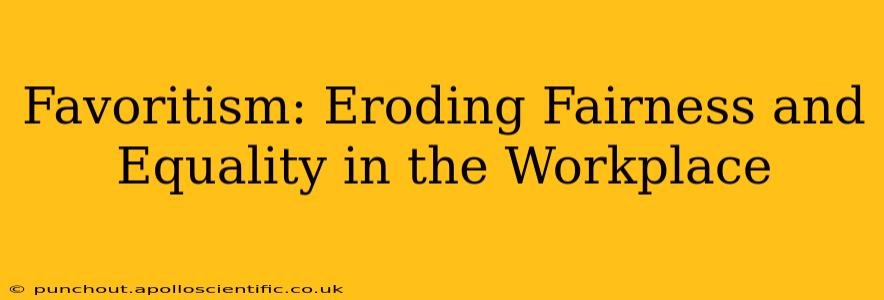Favoritism in the workplace, the showing of preferential treatment to certain employees, is a pervasive issue that undermines fairness, equality, and overall productivity. It creates a toxic environment where meritocracy is replaced by subjective biases, leading to decreased morale, increased turnover, and potential legal repercussions. This article delves into the insidious nature of favoritism, exploring its causes, consequences, and strategies for mitigating its damaging effects.
What is Workplace Favoritism?
Workplace favoritism occurs when a manager or supervisor consistently shows preferential treatment to certain employees, regardless of their performance or qualifications. This preferential treatment can manifest in various ways, including offering better assignments, providing more opportunities for advancement, offering more favorable work schedules, overlooking mistakes, or simply showing more warmth and support. The favored employees often have a personal connection with the manager, whether through shared background, social circles, or perceived loyalty. This creates an uneven playing field, where some employees feel valued and appreciated while others feel overlooked and undervalued. It's crucial to differentiate between genuine mentorship and favoritism; mentorship focuses on professional development for all employees, whereas favoritism prioritizes specific individuals unfairly.
How Does Favoritism Impact the Workplace?
The negative consequences of favoritism are far-reaching and can significantly impact a company's success.
-
Decreased Morale and Productivity: Employees who witness or experience favoritism are likely to feel demotivated, frustrated, and undervalued. This can lead to decreased productivity, increased absenteeism, and a general decline in workplace morale. The sense of injustice can be deeply damaging.
-
Increased Turnover: When employees feel they are not being treated fairly, they are more likely to seek employment elsewhere. Favoritism can contribute significantly to high employee turnover rates, resulting in increased recruitment and training costs.
-
Legal Ramifications: In some cases, favoritism can lead to legal challenges, particularly if it's based on discriminatory factors like race, gender, religion, or age. This can result in costly lawsuits and reputational damage.
-
Damaged Company Culture: A culture of favoritism fosters mistrust and resentment among employees. This can negatively impact collaboration, communication, and overall teamwork, hindering the company's ability to achieve its goals.
Why Does Favoritism Occur?
Several factors contribute to the prevalence of favoritism in the workplace:
-
Personal Biases: Managers, like all individuals, are susceptible to unconscious biases that influence their perceptions and decisions. These biases can lead to preferential treatment of employees who share similar characteristics.
-
Lack of Clear Performance Metrics: Without clear and objective performance metrics, it becomes easier for managers to rely on subjective judgments and personal preferences when making decisions about promotions, assignments, and rewards.
-
Weak Management Practices: Poor management practices, including a lack of transparency and accountability, can create an environment where favoritism can thrive.
-
Fear of Confrontation: Managers may avoid addressing issues of favoritism due to fear of conflict or retaliation from the favored employees.
What are the Signs of Favoritism in the Workplace?
Recognizing the signs of favoritism is crucial for addressing the issue effectively. Some common indicators include:
-
Consistent preferential treatment: Certain employees consistently receive better assignments, more opportunities, and more favorable treatment than others, regardless of their performance.
-
Ignoring or overlooking mistakes: Favored employees' mistakes are often overlooked or downplayed, while similar mistakes made by other employees are met with harsher consequences.
-
Unfair promotion practices: Promotions and raises are disproportionately awarded to favored employees, even if other employees are better qualified.
-
Unequal access to resources and opportunities: Favored employees have better access to training, mentorship, and other development opportunities.
-
Cliques and inner circles: The formation of exclusive groups within the workplace, often excluding others, is a clear sign of favoritism.
How Can We Prevent and Address Favoritism?
Combating favoritism requires a multifaceted approach that addresses both individual biases and organizational structures.
-
Implement objective performance evaluation systems: Clear, transparent, and measurable performance metrics are crucial for reducing bias in decision-making.
-
Promote diversity and inclusion training: Training programs aimed at raising awareness of unconscious biases can help managers make more objective and equitable decisions.
-
Establish clear policies and procedures: Implementing clear policies and procedures regarding promotions, assignments, and other important decisions can help ensure fairness and transparency.
-
Encourage open communication and feedback: Creating a culture where employees feel comfortable voicing their concerns without fear of retaliation is crucial for addressing favoritism effectively.
-
Provide regular management training: Training managers on effective leadership techniques, conflict resolution, and fairness can help prevent favoritism and build a more inclusive work environment.
-
Establish a confidential reporting system: A confidential mechanism for employees to report instances of favoritism allows for timely intervention and appropriate action.
Addressing favoritism is not simply about fairness; it's about creating a productive and thriving workplace where all employees feel valued and respected. By implementing these strategies, organizations can foster a more equitable and inclusive work environment that benefits everyone.

